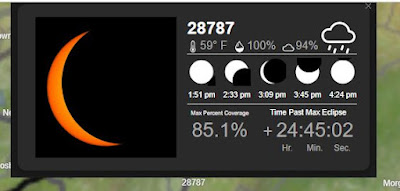Solar eclipses, whether total or partial, are one of those celestial events that leaves us in awe. I saw my first solar eclipse in March, 1970 in northern NY, followed by my second in May 1994 in Ann Arbor, MI, and in August 2017, also in Ann Arbor. I probably have a photo somewhere of the 1994 eclipse, but not of the actual eclipse, but of the projected images through tree leaves. The 2017 eclipse was pretty good, and I have some photos of the same type from that one. I was never previously prepared to photograph the eclipse directly. This time, however, I spent some time beforehand preparing myself. I really didn't want to have to travel a few hundred miles to be in the path of totality, and opted to stay home and take whatever we could see from Weaverville, NC. That was pretty much like my previous viewings, in that respect - never in the path of totality, but a show, nonetheless.
Based on this map from NASA, we'd be looking at a thin crescent at the maximum.
Of course, we had mostly cloudy weather, which would definitely impact the view. Looking at the track closest to us, it was probably a wise decision to stay put.
I had prepped two cameras for this - a Nikon Coolpix 5000 (vintage!) and my Canon EOS M5 with a 500mm mirror lens attached via an M42 adapter. There was a 4x ND filter and a single layer of reflective Mylar (from a "space blanket") on the Coolpix 5000, and a double layer of Mylar over the lens of the EOS M5. I also made a typical pinhole viewer for the eclipse, since I forgot to buy the "eclipse glasses." I didn't use the Mylar to put over my glasses - I don't mess around with my eyesight.
So, the day started out with scattered clouds and then went pretty much overcast at the time I set up to photograph. But, luckily, there were some breaks in the clouds and thinning of the cloud layer as the eclipse was underway.
Overall, everything worked as planned, but if I had it to do over again, I would have used a regular telephoto and not the mirror lens. The Coolpix 5000 captured the sky quite well, resulting in some images that Stieglitz would have died for. I should point out that using a mirrorless camera is a great thing for doing any photography of the sun. You avoid directly viewing through an optical viewfinder.
Meanwhile, the EOS M5 did okay.
However, the pizza tray with many holes was also kind of fun...
My 97 year old mother-in-law traveled from Amenia, NY to Rochester, NY and was able to experience the totality, even if it was cloudy. You don't get that chance many times in your life, and I'm glad she was able to experience it. Here in Weaverville, as the eclipse was starting, a neighbor was playing Dark Side of the Moon, which was perfect. As the crescent of the sun kept diminishing, it certainly did feel cooler, and the cardinals started singing like they do in the morning. It wasn't dark, of course, but the amount of light was greatly diminished. There was such a concerted media effort and NASA involvement that anyone could enjoy the experience whether they saw the sun or not.











No comments:
Post a Comment